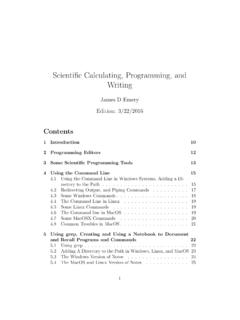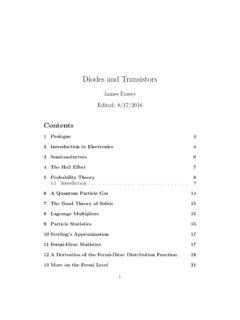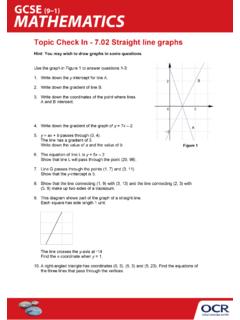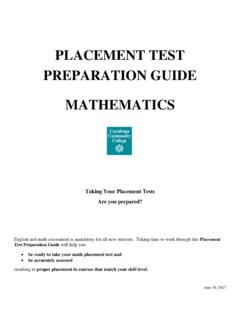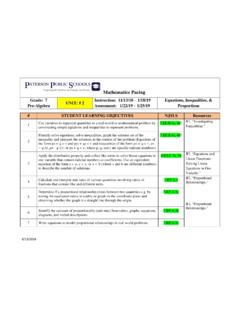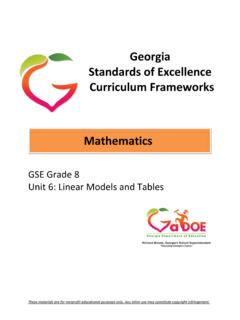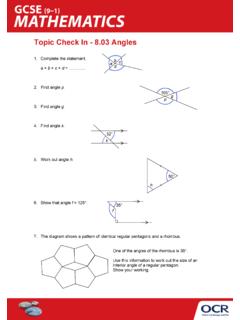Transcription of Experiments and Demonstrations - Stem2
1 Experiments and Demonstrations James Emery Latest Edit 9/12/2014. Contents 1 Introduction 5. 2 The Exploratorium 6. 3 Household Science 6. 4 Mathematical Puzzles and Curiosities 7. 5 Making a Polymer 7. 6 Chemistry 101, The Elements 8. 7 The Current and Voltage of A Lemon Battery 8. 8 Electrophoresis 8. 9 Radiation, Geiger Counters, Photoelectric Cells, Light Me- ters, Solar Cells 8. 10 Chaos in Chemical Reactions. 9. 11 Joule-Thomson Effect 9. 12 An Amplified Thermocouple 10. 13 Laser Ray Tracing, Scattering, and Defraction 10. 1. 14 Wireless Computer Connections 10. 15 Geometric Optics 10. 16 Accelerometer Experiments 11. 17 Air Table, Momentum Conservation, Elastic Collisions 11. 18 Wheatstone Bridge Measurements 11. 19 Static Electricity 11. 20 Experiments With Cathode Ray Tubes 12. 21 Piezo Electricity 12.
2 22 The Optical Activity of Crystals 12. 23 Young's Double Slit experiment . 12. 24 Oscilloscope Measurements 12. 25 Oscillators, Vibration 13. 26 Antennas, Radio, Radio Astronomy 13. 27 Polarized Light Experiments 14. 28 Studying Stress by Using Polarized Light 14. 29 The Ballistic Galvanometer and Its Modern Equivalent 14. 30 Computer Interfacing and Data Collection: LabWindows 14. 31 Measuring Field Intensity 15. 32 Magnetic Measurements, Hall Sensors 15. 33 Quantum Mechanical Spooky Action at a Distance 15. 34 Quantum Double Slit experiment 16. 2. 35 Laser Cooling and Trapping 17. 36 Mechanical Lissajous Figures. 17. 37 Vibration and Oscillation, Normal Modes 17. 38 Quantum Dots 18. 39 Nanotechnology 18. 40 Explanation of Experiments 18. 41 Companion Computer Programs. 19. 42 Losses in Transmission Lines 19.
3 43 demonstration of Fluorescence 19. 44 Speed Control of Electric Motors 20. 45 Gyroscopes 20. 46 The Conservation of Angular Momentum 20. 47 Extracting and Amplifying DNA 20. 48 Chromatography 21. 49 Genomic Computations 21. 50 Electrochemistry and Electroplating 21. 51 Constructing an Antenna 21. 52 Reconstructing Ancient Experiments . 22. 53 The Equipartition of Energy. 22. 54 The Wilberforce Pendulum. 22. 55 The Magnetron 23. 3. 56 Coupled Pendulums 23. 57 Mechanical Linkages 23. 58 Gear Motion 23. 59 Tribology or Friction 24. 60 Steering Control, Steering Geometry 24. 61 Mechanical Advantage, Energy, Transmissions 24. 62 Ignition Coil, Spark Plugs 24. 63 Metallurgy and Welding 25. 64 Plasma 25. 65 Induction Heating and Eddy Currents 25. 66 The Mathematics of Robotics 26. 67 Precision Measurement 26.
4 68 Interferometers 26. 69 The Statistics of Experimental Error 26. 70 The Design of Experiments 27. 71 Black Smithery, Building a Forge 27. 72 The Carbon Arc 27. 73 Optics, Telescopes, and Microscopes 27. 74 Solar Heating 27. 75 The Atmosphere, The Greenhouse Effect, Ultraviolet, In- frared 28. 4. 76 Entropy 28. 77 The Calculus of Variations, The Brachistochrone, Hamilton's Principle 28. 78 Scanning Electron Microscope 29. 79 Simple and Compound Pendulums 29. 80 Stopping Wave Motion With a Stroboscope 29. 81 High Speed Photography 29. 82 The Fountain Pen, Capillary Flow 30. 83 Parabolic Solar Collectors 30. 84 Observing Brownian Motion 30. 85 The Climbing Spark of Scifi Movies 31. 86 Nitrogen Triiodide Chemistry demonstration 31. 87 Photoelectric Effect 32. 88 Metalurgy: Heated Iron Wire 33.
5 89 References 33. 1 Introduction Here we present Experiments and Demonstrations for students of all ages, people who want to know and understand. This list will be edited and revised over time. The rather grand idea is to have a kind of Science Museum that would function like a public library, with Experiments , Demonstrations , and apparatus, serving as the books. We shall give Internet references and YouTube links. We invite general participation in this endeavor. Ideally this might be done in a Wiki on the net, where contributors could add and edit 5. entries. Temporarily, we could use email, sending information to a central point. Perhaps I might serve temporarily as such a point: In order to generate notice we need to physically construct apparatus for Demonstrations . Secondly, perhaps a subgroup of us will pursue the acquisition of resources and the creation of a formal plan for this activity.
6 Below we make a start on a list. We realize that some elements of this list are familiar and obvious cliches. As we create Experiments and do Demonstrations , we should record them with pictures and videos, that would be placed on our website. 2 The Exploratorium The Exploratorium in San Francisco is a model for science museums. There was a NOVA program in the early eighties on the exploratorium and its founder Frank Oppenheimer. He is the brother of J. Robert Oppenheimer. This program is called The Palace of Delights, and can be viewed on the Exploratorium WEB site: 3 Household Science Ignorance of elementary science makes people do very silly things in ordinary life. This can be quite irritating. Does a fan cool the air? Can you clean a greasy plate by soaking it in water? What is soap? What does a detergent do?
7 Can you increase the temperature of boiling water by turning up the flame? What is it about oil or fat that prevents burning food in a frying pan? If your dog chews the electric cord, can the juice leak out? What is the difference between AC and DC, and between analog and digital. What is radiation? If you open just one window, will the cool air come in? Does a penicillin shot cure a cold? If one is driving down a flat icy road in a straight line, can the car suddenly go off the road and crash into a tree? Schools should make a special effort to erase these implied misconceptions. 6. 4 Mathematical Puzzles and Curiosities We should devise physical puzzles and models that illustrate mathematics. One could demonstrate a mean spirit by creating a race between two people to solve the fifteen puzzle, after one of the puzzles has been modified by physically transposing two of the numbers.
8 This makes that puzzle impossi- ble to solve. One could show how to construct an algorithm to make magic squares, and then write a computer program that performs the algorithm. We could present a proof that all triangles are isosceles, and so show that mathematics is about thinking, not about rapid and accurate calculation. We could present the proof that a horse has no legs. Or we could create coin puzzles to show that money can be interesting. 5 Making a Polymer Elmer's glue (polyvinyl acetate) and Borax can be used to cross-link a poly- mer, and make a material similar to silly putty. Ethylene is the compound H2 CCH2 , an unsaturated hydrocarbon with a carbon double bond. Vinyl is the univalent chemical radical CH2 CH, derived from ethylene. The acetate anion, [CH3 COO] , is a carboxylate and is the conjugate base of acetic acid.
9 The acetate ion is formed by the deprotonation of acetic acid: CH3 COOH CH3 COO + H +. polyvinyl acetate, PVA, is the polymer chain (H2 CCHOOCCH3)x As an emulsion in water, PVA is sold as an adhesive for porous materials, particularly wood, paper, and cloth. It is the most commonly used wood glue, both as white glue and the yellow carpenter's glue.. PVA is widely used in bookbinding and book arts due to its flexibility, and because it is non-acidic, (unlike many other polymers) is used extensively in paper, paint and industrial coatings when it is referred to as vinyl acrylic. 7. It is slowly attacked by alkali, forming acetic acid as a hydrolysis product. Boron compounds like boric acid or borax will form tackifying precipitates by causing the polymer to cross-link. Retrieved from 6 Chemistry 101, The Elements Click the link below and study chemistry with a song by Tom Lehrer.
10 7 The Current and Voltage of A Lemon Bat- tery A battery made from a lemon, a zinc galvanized nail, and a copper coin generates a voltage. But is there enough current to illuminate a light bulb? YouTube Create a Lemon Battery YouTube Lemons for Mr. Wizard 8 Electrophoresis Large molecules often have charges on their surfaces. An electric field gradi- ent due to a voltage difference, in a wet paper towel, or more professionally in a gel, can lead to the separation of molecules due to a variation in their speed of migration. This is widely used in biology. Reference: 9 Radiation, Geiger Counters, Photoelectric Cells, Light Meters, Solar Cells The photoelectric effect can be demonstrated with an electroscope and a source of ultraviolet light. The electroscope is statically charged. The elec- 8.



